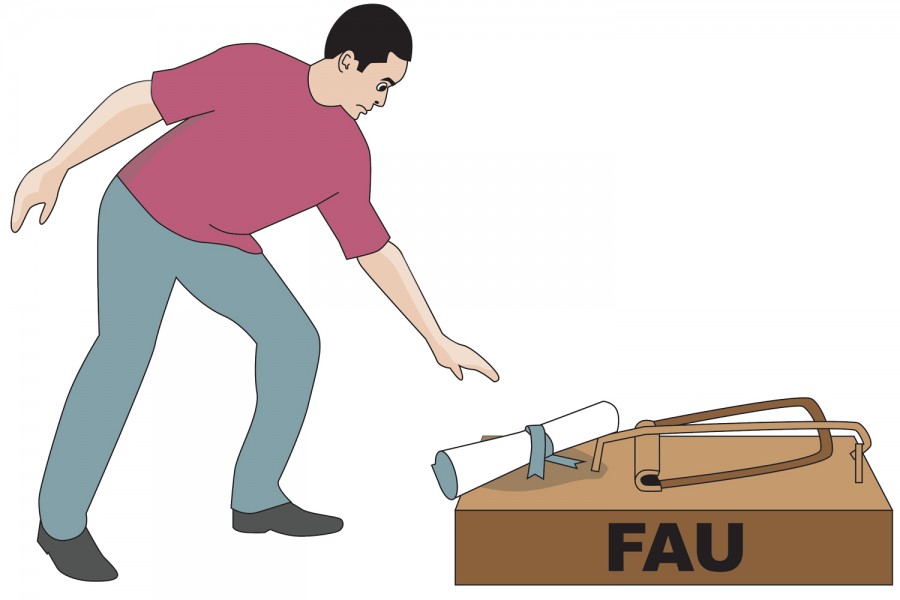Transfer students lose money, retake more classes than they bargained for
Repeating coursework and repaying tuition, students share their transfer horror stories.
March 1, 2016
Taylor Krause has taken 10 college English courses. Now, she’s on her 11th — ENC 1101.
She’s supposed to be a junior, but since many credits from her old university didn’t count, she’s listed as a sophomore. Next semester, she’ll have to take ENC 1102.
And she’s not alone.
Whether the school is private or public, international or within the U.S., it can be a struggle for transfer students to get their credits counted to avoid retaking classes.
Krause, who is studying biology, transferred from Lynn University, a private school just down the street from FAU. “I don’t understand why I’m taking freshman English, because I literally did 10 of them at Lynn,” she said.
“I’m going from a private school to a public school, and Lynn is just completely different.”
When someone transfers from another university, they typically don’t find out which of their credits count until after acceptance and enrollment.
FAU’s website does not provide information for what students can expect after they are accepted to the university, like how their credits will be counted and distributed.
The website’s section for transfer applicants confirms that students cannot meet with an advisor to find out which credits transfer before they apply.
“Unfortunately, the Office of Admissions does not staff academic advisors that can sit down and go over your current transcript with you personally,” the page says. “Students who are accepted to the university will meet with an academic advisor who can better answer specific questions regarding transferable credits and degree requirements.”
The website provides information on how to apply to the university, but not on how credits will be counted. And some students that already have an associate degree before transferring may have more problems to face.
“I transferred in from an international school, and I came in with an associate degree already, so typically I should have only done two years of class, but they are kind of forcing me to do another four years,” a student who chose to stay anonymous told the University Press. “I had 65 credits [originally], but only four counted at FAU.”
That student has to fulfill a 120-credit minimum all over again. “I would assume it would be a money thing, like they are just forcing me to pay more money. Why else would they force me to do classes I’ve already done?”
When the student went to the University Advising Services to see why so many classes were required to be taken over, he claims to have been given “runaround answers.”
“I honestly still don’t know where I am [with my classes]. I just go to advising every semester and ask them for help with classes … they refuse to actually tell me what I have left,” he said.
Admissions Coordinator Michele Paredes, as well as the admissions office, did not respond to requests for comment.
After going to the registrar’s office, the student went to the dean of students multiple times, as well as advising for the department of his major. The dean asked the student to keep him updated, but the student said he never really did anything.

After more than a year of taking classes here, the student still counts as a junior. “I was even considering transferring back to continue where tuition is free, where I am from, because these classes cost a lot of money and I pay out-of-state tuition.”
Sometimes credits are declared non-transferable because a college’s or university’s accreditation is not recognized by FAU.
That was the case with Logan Smith, marketing major from Digital Media Arts College, a three-year institution in Boca Raton, three miles away from FAU.
He lost six semesters, a total of two years, transferring to FAU. DMAC originally told him that the school was accredited, but he later found out that wasn’t the entire truth.
“There was a situation where I couldn’t get past a certain point, and I was like, ‘Alright, well I’ll go to a different school,’ and [FAU is] like, ‘Yeah, those credits don’t come here,’” Smith said.
According to its website, “Generally, FAU accepts credits from regionally accredited institutions in which the students received a grade of ‘D’ or better in college-level courses.”
Smith doesn’t blame FAU for this credit mix-up. “DMAC didn’t go through this process [to get accredited], [FAU] would probably have taken care of it if it was”
According to FAU’s Office of Institutional Effectiveness and Analysis, 50 percent of the school’s 24,000 undergraduates in 2014 were transfers. In that same year, 3,827 transfer students were accepted to the school, while 2,438 ended up enrolling.
Brittany Ferrendi is the features editor of the University Press. If you would like to contact her regarding this or other stories, she can be reached at bferrend@fau.edu.






